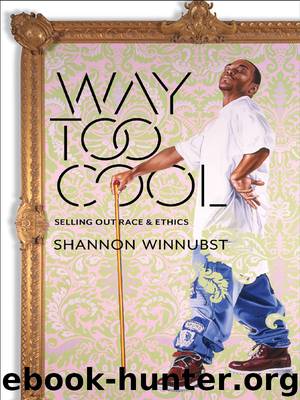Way Too Cool by Shannon Winnubst

Author:Shannon Winnubst
Language: eng
Format: epub
Tags: SOC022000, Social Science/Popular Culture, SOC031000, Social Science/Discrimination & Race Relations
Publisher: Columbia University Press
Published: 2015-09-07T16:00:00+00:00
WELCOME, METROSEXUALITY
The cultural emergence of metrosexuality in the United States and United Kingdom in the early 2000s offers a particularly apt example for analyzing these transformations. Proclaimed the coolest, latest thing on the cover of the New York Times Magazine in 2003, metrosexuality came on the scene as the coolest, latest thing the neoliberal market had cooked up. Of course, the fashion industry had known this for some time: any good neoliberal knows that a style has already lost its edge by the time it reaches the cover of the New York Times Magazine. Still, the play of androgyny and, particularly, the making cool of effeminate masculinity in metrosexuality became confusing cultural phenomena for feminist and queer theorists, for a short while. (Metrosexuality was officially proclaimed dead in 2012, since it is passé to note that which is fully mainstream; and, as the cartoon in the New Yorker in 2013 shows, it is clearly mainstream.)18
On the one hand, following Butler’s lead, gender-bending had been hailed (pun intended) by feminists as one of the ultimate barometers of social change, a sure sign that the patriarchy was crumbling. But as metrosexuality has become cool and hip, nothing seems to be changing: economic indicators such as the gender gap in employment, wages, and salaries have not substantially changed; the wedding industry is flourishing and about to be boosted in unforeseen ways as same-sex marriage is gradually legalized; and the assault on women’s reproductive rights and justice is intensifying across the United States. So, what is going on? How is it that gender-bending has been co-opted as the latest, coolest thing by the neoliberal market? And what does this tell us about the transformation in categories of social difference as well as processes of subject formation in neoliberalism?
To analyze this, I first return to Judith Butler’s Gender Trouble, which became remarkably popular roughly a decade before the cultural emergence of metrosexuality. Arguably the most culturally challenging aspect of Butler’s work in Gender Trouble was her link of gender binaries and normativity to a heterosexist concept of sexuality. This was, of course, not news to feminists, who had been analyzing and articulating the endemic connections of sexism and heterosexism, sometimes alongside white supremacy, for some time by 1989. The 1970s were overflowing with feminists, across a range of ideological and political affinities, calling out the constrictive roles that patriarchal sexism forced upon women, including quite directly the constitutive roles of heterosexism and white supremacy. The names doing such work from a wide variety of (often conflicting) cultural standpoints far exceed any single, exhaustive list: Shulamith Firestone, Kate Millett, Robin Morgan, Susan Brownmiller, Gloria Steinem, Cheryl Clarke, June Jordan, Audre Lorde, Angela Davis, bell hooks, the Combahee River Collective, Catherine MacKinnon, Andrea Dworkin, etc. (A very different kind of twist on the now infamously Butlerian “etc.”) I particularly emphasize Hortense Spillers’s remarkable essay “Mama’s Baby, Papa’s Maybe: An American Grammar Book,” published in 1987, which thoroughly racializes gender as a critical tool of chattel slavery and colonialism (an argument María Lugones continues to develop).
Download
This site does not store any files on its server. We only index and link to content provided by other sites. Please contact the content providers to delete copyright contents if any and email us, we'll remove relevant links or contents immediately.
Rewire Your Anxious Brain by Catherine M. Pittman(18553)
Talking to Strangers by Malcolm Gladwell(13222)
The Art of Thinking Clearly by Rolf Dobelli(10221)
Mindhunter: Inside the FBI's Elite Serial Crime Unit by John E. Douglas & Mark Olshaker(9201)
Becoming Supernatural by Dr. Joe Dispenza(8119)
Change Your Questions, Change Your Life by Marilee Adams(7635)
Nudge - Improving Decisions about Health, Wealth, and Happiness by Thaler Sunstein(7615)
The Road Less Traveled by M. Scott Peck(7522)
The Lost Art of Listening by Michael P. Nichols(7406)
Enlightenment Now: The Case for Reason, Science, Humanism, and Progress by Steven Pinker(7235)
Mastermind: How to Think Like Sherlock Holmes by Maria Konnikova(7227)
Win Bigly by Scott Adams(7094)
The Way of Zen by Alan W. Watts(6506)
Daring Greatly by Brene Brown(6445)
Big Magic: Creative Living Beyond Fear by Elizabeth Gilbert(5610)
Grit by Angela Duckworth(5523)
Ego Is the Enemy by Ryan Holiday(5294)
Men In Love by Nancy Friday(5155)
Altered Sensations by David Pantalony(5045)
